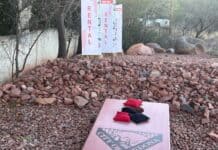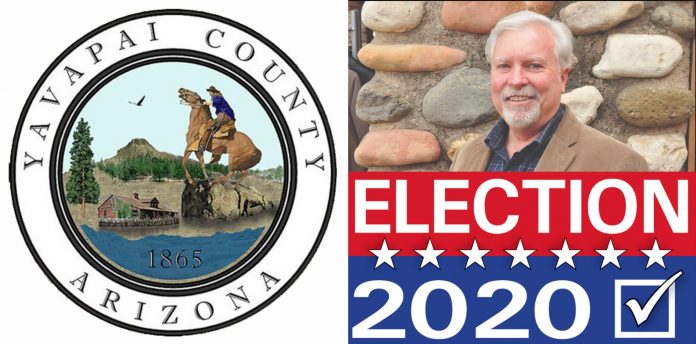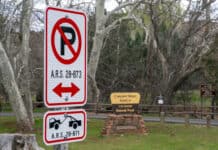Randy Garrison first ran for Yavapai County supervisor in 2016, but despite only serving for one term so far, he has spent his time as one of the most central players in local politics.
Coming from a family that included a former mayor of Cottonwood and a former county supervisor, the current vice chairman of the Board of Supervisors previously served as a Cottonwood city councilman and on the Mingus Union High School District Governing Board. Since joining the board of supervisors, he has been chairman once and vice chairman twice, something he touts with pride.
“I’ve built really strong relationships with the other board members on the Board of Supervisors,” Garrison said. “They’ve given me a lot of room to lead …. You don’t get there by accident.”
A Republican, he is facing Democratic challenger Donna Michaels in the election on Tuesday, Nov. 3.
Garrison argues that his connections as well as his knowledge of county issues and processes have made him a good representative of District 3, through his ability to improve services in the Verde Valley by lobbying the board, as well as state and federal governments, such as in a recent land exchange where the county swapped land with the U.S. Forest Service, with the help of U.S. Rep. Paul Gosar [R-District 1].
Garrison boasts of having brought in $30 million in federal grants for road construction to the Verde Valley, though one project he had briefly pursued — the proposed Red Rock Crossing connecting Sedona and the Village of Oak Creek — was put on hold due to opposition from VOC residents, with Garrison expressing no desire to bring it back.
The biggest county project Garrison supports is the proposed Verde Connect road connecting Beaverhead Flats Road with State Route 260, in Supervisor District 2.
The county was awarded a $25 million grant from the federal government for the road, which Garrison argues would alleviate traffic congestion in Cottonwood and on Cornville Road, though some Camp Verde residents near the road’s path have objected to it.
“When I got my seat, I listened to the community, and traffic was one of the top issues on the list,” Garrison said. “We’re getting a significant amount of traffic going through Cornville …. Traffic isn’t going to get better. It’s only going to get worse. If we don’t find a way to move that traffic away more efficiently, we’re only going to have more impact on communities like Cornville.”
In addition to advocating for more road construction, Garrison hopes to find ways to encourage more housing development in the area, while also trying to keep the Verde Valley’s rural character intact. He lamented the way that the fight over the Spring Creek Ranch development has unfolded, with the property owners seeking annexation with Cottonwood as a way to go around Cornville residents. Garrison argued that the two parties should have been able to worktogether to find a solution that allowed for new housing within reasonable restrictions sought by the residents of Cornville.
“I like that the Verde Valley has remained rural as long as it has, [but] we should expect that we’re going to continue to have growth,” Garrison said. “The Verde Valley is 87% public space. We’re never going to be Prescott Valley. We’re never going to be Phoenix. There’s only so much private land to develop.”
Garrison argues in favor of the decision by the Board of Supervisors to raise property taxes by 3% to pay for a new criminal justice complex in Prescott, arguing that the Yavapai County Sheriff’s Office had determined that the Yavapai County Detention Center in Camp Verde cannot safely house the total number of inmates the county is dealing with, and that in the long run, it would save county residents, including those in the Verde Valley, money on criminal justice costs.
“If you get arrested on the streets of Chino, they have to drive you to Camp Verde and process you,” Garrison said. “Then [the officer] has to drive back to Chino. For one prisoner, you’ve taken an officer off the streets of Chino for an entire day…. That costs us a ton of labor and money to move prisoners back and forth.”
Though he does not take a firm position on what should happen, Garrison believes that some of the unincorporated areas in District 3 will end up changing their legal status in the coming years. Garrison thinks that as the Village of Oak Creek grows not only in population but also commercially, it will have the tax base to be able to incorporate as an independent entity, while he thinks that the Verde Villages, which already depends on Cottonwood for essential services like water and sewer, would see the value in annexing into Cottonwood.
Garrison sits on the board of Northern Arizona Healthcare and made a commitment as a board member that while administrators have discussedre-evaluating its Sedona Emergency Department, the hospital system would retain its presence in the area and not reduce what it offers residents.
“I sit on that board specifically to speak out for our communities,” Garrison said. “We constantly have to re-evaluate the service. Sedona is not looked at more or less than the Verde Valley Medical Center or the Flagstaff market.”
Garrison views the COVID-19 issue as still an uncertain factor looking toward the future and stressed the need for vigilance in fighting the pandemic, including urging physical distancing and mask usage. However, he opposes a county-wide mask ordinance, at least for the time being. He pointed to the Board of Supervisors having given the chairman emergency executive power, which could mean implementing a mask ordinance in the future, but also said that he did not know whether the area would see a new spike that would make it necessary.
With the pandemic affecting the economy of the area and exposing the precarity of the tourism industry, Garrison believes that communities and the county will have to be proactive and find ways to improve growth. He pointed to the opportunity zone north of Camp Verde as one example, and argued that the Village of Oak Creek’s commercial and population growth make it a prime area to develop its own economic growth, independent of Sedona.
Garrison argued that he would be the one most prepared to navigate the area through the coming transitions, due to his experience and accomplishments.
“I’ve been very successful these four years,” Garrison said. “I’ve been more successful than any board members. I’ve only been able to do that because of the relationships I’ve spent years building.”
“If we lose that voice, I’m really nervous about the direction things will go.”






















